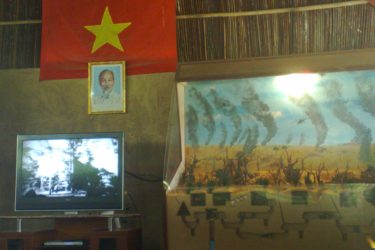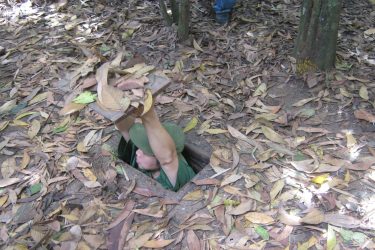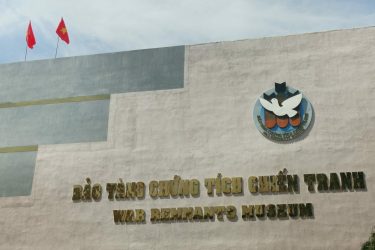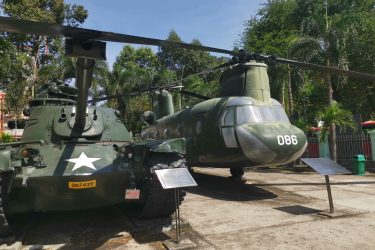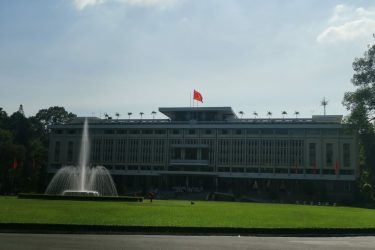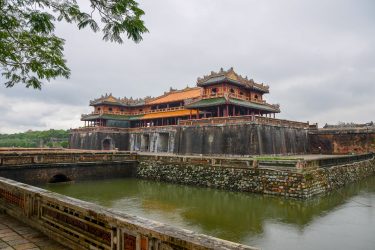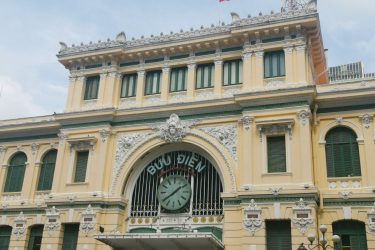Vietnam is home to a number of important Vietnam War sites that provide profound insights into the turbulent history of the nation. In addition to offering tourists the chance to learn about the history of the nation and the effects of the war on Vietnam and its people, these locations serve as potent reminders of the fighting. These locations, which are dispersed throughout the nation, serve as a reminder of the Vietnamese people’s resilience and tenacity as well as a memorial to the battle.
The Cu Chi Tunnels, located close to Ho Chi Minh City, are among the most famous locations. The Viet Cong’s guerrilla warfare strategies heavily relied on this complex system of subterranean tunnels. Parts of the tunnels are open for visitors to explore, giving them a first-hand look at the difficult circumstances that the soldiers faced. The event emphasizes the resourcefulness and tenacity of those who battled, and it is both enlightening and depressing.
The War Remnants Museum in Ho Chi Minh City provides a thorough account of the conflict from the Vietnamese point of view. The terrifying images, military hardware, and first-hand accounts that highlight the human cost of the fight are all on display at the museum. Anyone interested in learning more about the war’s wider effects on Vietnam should definitely check it out.
Exploring the Demilitarized Zone (DMZ), which formerly separated North and South Vietnam, is another important place. Important locations like the Khe Sanh Combat Base and the Vinh Moc Tunnels highlight the region’s strategic significance as well as the fierce fighting that took place there.
Vietnam’s history can be better understood by visiting these battle locations, which give viewpoints not found in textbooks. It’s an educational experience that also pays tribute to the people who endured one of the hardest times and offers insights into the nation’s history. In this article, we will give you some of the must see Vietnam War sites you must visit when you go to the beautiful country of Vietnam.
Visit the Dien Bien Phu Battlefields
A trip to one of the most important and historic locations in Vietnam’s contemporary history is the Dien Bien Phu Battlefields. This region, which is part of the northwest province of Dien Bien, is well-known for its involvement in the crucial Battle of Dien Bien Phu, which was fought there from March to May 1954. This combat served as a turning moment in the fight for Vietnamese independence and signaled the end of French colonial control in Indochina.
The battleground is dispersed over a number of hills and valleys, which served as the main strategic locations during the conflict. Explore a number of important sites, such as the old French military installation that is now home to a number of monuments and artefacts. The artillery positions, bunkers, and trenches provide a clear picture of the fierce fighting that transpired. Among the important locations is the Dien Bien Phu Museum, which has an extensive collection of relics, pictures, and records pertaining to the conflict.
The General Giap’s Command Post, where visitors can observe the position from where the Viet Minh leader led the combat, is one of the most famous sights. The War Cemetery, which honors dead troops from both sides, is another important location.
A thorough grasp of the strategic, historical, and emotional significance of the conflict can be gained by visiting the Dien Bien Phu Battlefields. It sheds light on the Viet Minh forces’ tenacity and their triumph over a colonial force, influencing Vietnam’s future and its route toward independence.
Visit the Cu Chi Tunnels in Vietnam
A singular and impactful window into Vietnam’s history during the Vietnam War is provided by a visit to the Cu Chi Tunnels. The large network of subterranean passages known as the Cu Chi Tunnels is situated roughly 70 kilometers northwest of Ho Chi Minh City and was utilized by the Viet Cong forces during the fighting. Deep below the surface of the ground, these tunnels served as living quarters, supply channels, refuge, and even hospitals for the Viet Cong, making them an essential part of their guerrilla warfare strategy.
You will get to see this complex subterranean system when you visit the Cu Chi Tunnels. The tunnels still depict the small, dim, and difficult circumstances that soldiers faced, despite having been kept and somewhat expanded to accommodate tourists. Parts of the tunnels are crawl able, allowing visitors to get a first-hand look at what life could have been like for the Viet Cong warriors who battled and resided there.
The location features displays of different weaponry, traps, and war artefacts used during the battle in addition to the tunnels. Additionally, there are displays showing how the Viet Cong built the tunnels and other novel survival strategies they used. The historical background that guided tours frequently offer helps visitors comprehend the strategic significance of the tunnels as well as the enormous difficulties experienced by the people who lived below.
Few other locations can compare to the profound and informative experience that the Cu Chi Tunnels provide in bringing the history of the Vietnam War to life. The tour is memorable because it sheds light on the Vietnamese people’s tenacity and inventiveness at one of the most trying times in their history.
Visit the War Remnants Museum in Ho Chi Minh City
One of the most powerful experiences is visiting the War Remnants Museum in Ho Chi Minh City, which offers a thorough examination of the Vietnam War from the Vietnamese point of view. One of the most well-liked sights in the city, the museum is situated in District 3 and draws tourists from all over the world who want to learn about the war’s significant effects on Vietnam.
The museum’s displays, which span many floors, feature a vast array of images, records, and objects. The displays, which portray the horrific reality of battle, are striking and frequently disturbing. The consequences of Agent Orange, a chemical defoliant employed by US soldiers throughout the war, are covered in one of the most dramatic portions. Visitors are left with a lasting impact by the photos and testimonies of the victims, some of whom were children born with severe deformities.
The My Lai Massacre, a horrific incident in which hundreds of defenseless Vietnamese people were murdered by American soldiers, is the subject of another noteworthy exhibit. In addition, the museum features an array of military relics, such as tanks, helicopters, and explosives, all of which are on exhibit in the courtyard and provide a concrete link to the fighting.
The War Remnants Museum acts as a reminder of the Vietnamese people’s tenacity even if it presents a graphic picture of the conflict. Unquestionably, the museum’s story is Vietnamese-centric, emphasizing the hardships and suffering endured by both soldiers and civilians.
The War Remnants Museum provides an unvarnished look at the Vietnam War and its lasting effects, making a visit both educational and poignant. For anyone interested in history or the human cost of conflict, this location is a must-see since it fosters introspection and understanding.
If you would like to know what you should do and see in Ho Chi Minh City click here go to our post where you will receive the best information and some of our recommendations.
My Lai Massacre Memorial in Quang Ngai Province
Situated in Quang Ngai Province, the My Lai Massacre Memorial serves as a melancholy and emotional memorial of one of the most horrific incidents of the Vietnam War. In the hamlets of My Lai and My Khe, on March 16, 1968, American soldiers from Charlie Company, 1st Battalion, 20th Infantry Regiment massacred hundreds of defenseless Vietnamese villagers, the majority of whom were women, children, and the elderly. The My Lai Massacre, an act of terror that startled the world, came to represent the savagery of the war.
The 504 victims are honored at this memorial site, which is situated in the village of Son My. Visitors can have a thorough understanding of the events that took place thanks to the museum, memorial, and surviving parts of the historic settlement. Offering a terrifying window into the horrors endured by the locals, the museum features eerie photos, victim personal effects, and in-depth narratives of the slaughter.
The memorial is a massive stone sculpture that represents the pain of the innocent. It shows a sobbing mother clutching her slain child. Markers designating the sites where families were slain surround the monument, honoring the memory of every life lost.
Visitors are frequently astounded by the tranquility of the surroundings as they stroll around the site, which stands in stark contrast to the carnage that took place there. In addition to serving as a monument of remembering, the My Lai Massacre Memorial invites contemplation on the horrors of war and the value of peace.
The My Lai Memorial serves as a poignant and necessary window into the harsher facets of Vietnam’s past for tourists, serving as a constant reminder of the human cost of war.
Visit the DMZ (Demilitarized Zone) in Vietnam
A compelling look into Vietnam’s war-torn past can be had by visiting the Demilitarized Zone (DMZ). As a heavily defended region where some of the Vietnam War’s most severe combat took place, the Democratic Military Zone (DMZ), which formerly separated North and South Vietnam along the 17th parallel, was vital to the struggle. As a historical landmark, it provides tourists with an insight into the devastation caused by the conflict.
The DMZ is a roughly 5-kilometer-long buffer that runs along both banks of the Ben Hai River. Inside this buffer, tourists can explore a number of significant locations that provide insight on the history of the conflict. A noteworthy example is the Vinh Moc Tunnels, a complex system of subterranean passageways via which entire communities subsisted in order to avoid bombs. You get a terrifying impression of the terrible circumstances the Vietnamese people faced during the war by walking through these tunnels.
The Hien Luong Bridge, which was formerly the sole point of entry between North and South Vietnam, is another significant location. The bridge, which has been reconstructed, represents the country’s split and eventual reunification. The DMZ Museum, which is close by, offers more context for the war through its displays of images, military relics, and first-hand accounts from people who experienced it.
Within the DMZ are the Con Thien Firebase and Khe Sanh Combat Base, both of which were important locations for battles. People who want to learn about the strategic military significance of the DMZ during the conflict frequently visit these locations.
Travelers can have a significant connection with Vietnam’s past through a visit to the DMZ, which is a powerful experience. It offers a somber perspective on the price of war by serving as a reminder of the war’s lingering effects on the nation and its citizens.
Visit the Hoa Lo Prison (Hanoi Hilton) in Hanoi
Often referred to as the “Hanoi Hilton,” Hoa Lo Prison provides a moving window into the turbulent past of Vietnam. This infamous jail is situated in the center of Hanoi and was initially constructed in the late 19th century by French colonialists to house political prisoners from Vietnam who challenged their rule. The towering stone walls and iron bars that make up the prison’s architecture depict its gloomy function as a place of control and punishment.
Hoa Lo Prison became well-known worldwide during the Vietnam War for being the detention center for American POWs, which included Senator John McCain. The moniker “Hanoi Hilton” was a darkly humorous allusion to the inhumane circumstances that the detainees had to endure. The prison complex’s museum currently spends a large amount of time chronicling the lives of these American inmates, displaying images, personal effects, and graphic testimonies of their incarceration.
In addition to its involvement in the Vietnam War, the prison is a symbol of the Vietnamese people’s tenacity in the fight for independence. Exhibits depict the harsh living conditions Vietnamese revolutionaries had during the French colonial era, including small quarters, torture tools, and displays showing the valiant attempts of incarcerated individuals to get free.
Hoa Lo Prison is now a museum that gives visitors a grim but insightful look at the Vietnam War’s intricacies and the history of Vietnamese resistance. It is a must-visit location for anybody interested in learning about Vietnam’s past because it serves as a sobering reminder of the misery that many people went through during these times. Everyone who attends will be left with a lasting impact by the poignant and instructive event.
Visit the Independence Palace in Ho Chi Minh City
A trip through modern Vietnam can be had by visiting Ho Chi Minh City’s Independence Palace, also called Reunification Palace. During the Vietnam War, this famous building housed and worked for the South Vietnamese President, and it is now a reminder of the nation’s stormy past.
The palace has a rich and fascinating past. Saigon fell and the Vietnam War ended on April 30, 1975, when a North Vietnamese tank spectacularly burst through its gates. Visitors can view a copy of the tank on the royal grounds, serving as a potent reminder of that crucial moment. This incident is commemorated within the palace.
The Independence Palace’s architecture combines modernist architecture from the 1960s with features of traditional Vietnamese architecture. The apartments within have been kept exactly as they were during the conflict, providing an insight into the leaders of South Vietnam’s personal life. Explore the magnificent meeting rooms, battle command room, and private quarters, all furnished with antiques and war relics.
The subterranean bunkers of the palace, furnished with communication devices and maps, offer valuable insights into the tactics and workings of the war effort. The harsh, functional bunkers contrasted with the opulent top levels highlight the opposing realities of power and combat throughout the war.
Seeing the Independence Palace is not just about taking in the architecture; it’s also about realizing the lasting effects of the Vietnam War on the nation. For anybody interested in the history of Vietnam, a visit to the palace is a must because it serves as a testament to the country’s resiliency and unity.
Visit the Reunification Palace in Ho Chi Minh City
A interesting peek into Vietnam’s recent history may be had by visiting the Reunification Palace in Ho Chi Minh City, formerly known as the Independence Palace. This landmark is a must-see for history buffs and inquisitive tourists alike because it represents the conclusion of the Vietnam War and the reunification of the nation.
The Reunification Palace is a masterwork of architecture that combines traditional Vietnamese characteristics with modernist style from the 1960s. During the conflict, the structure housed and accommodated the South Vietnamese President’s office. When a North Vietnamese tank famously crashed through its gates on April 30, 1975, announcing the fall of Saigon and the end of the Vietnam War, it gained international significance. A striking reminder of that momentous day is provided by the replica of this tank that is currently on exhibit on the royal grounds.
Explore a variety of rooms inside the palace that have been kept exactly as they were throughout the conflict. These consist of the combat command center, the President’s office, and the reception areas, which are furnished with antiquated communication devices and maps. The subterranean bunkers are especially fascinating since they provide information about the tactics and actions used during the war.
The Reunification Palace, with its sumptuous meeting rooms, banquet halls, and private quarters, provides an insight into the extravagant lifestyle of the South Vietnamese aristocracy. The austere, utilitarian design of the bunkers contrasts sharply with the grandeur of the top levels, highlighting the conflicting realities of combat and government at the time.
A moving experience that provides a historical and cultural perspective on Vietnam’s path through war and peace is a visit to the Reunification Palace. It is evidence of the country’s tenacity and the lasting importance of its reunification.
Visit Hue Imperial City
It’s like taking a trip back in time to Vietnam’s imperial past when you visit the Hue Imperial City. Hue, which lies in the country’s centre, served as the capital of Vietnam’s final governing dynasty, the Nguyen Dynasty, from 1802 to 1945. The Imperial City, sometimes referred to as the Citadel, was a vast complex that housed the dynasty’s political, cultural, and religious institutions.
Thick stone walls and a moat encircle the Imperial City, forming a strong defensive system that shielded the royal family and their court. The Forbidden Purple City, which was only accessible to the emperor and his close allies, is the most significant area of the Citadel. Visitors can still explore the ruins of the Forbidden Purple City and imagine the majesty that once there, even though much of it was destroyed during the Vietnam War.
Hue Imperial City’s architecture, which has elaborate carvings, minute mosaics, and elaborate temples, is a fusion of traditional Vietnamese and Chinese styles. The Thai Hoa Palace, where the emperor would host formal events and host guests from abroad, is one of the most striking buildings. One of the palace’s highlights is the golden throne room, which displays the splendor of the imperial court.
The Nine Dynastic Urns, which stand in for the strength and longevity of the Nguyen emperors, are also visible to visitors. Every urn is beautifully adorned with pictures of the natural world and is devoted to a distinct emperor.
Discovering the Hue Imperial City provides a unique perspective on the cultural legacy of the Nguyen Dynasty and Vietnam’s imperial past. For everyone interested in learning more about Vietnam’s fascinating history, this site is a must-visit because to its remarkable architectural beauty and historical significance.
If you would like to know what you should do and see in Hue click here go to our post where you will receive the best information and some of our recommendations.
Visit the Saigon Central Post Office in Ho chi Minh City
Exploring the colonial legacy and architectural magnificence of Ho Chi Minh City is possible through a visit to the Saigon Central Post Office. Designed by the renowned architect Gustave Eiffel, who also created the Eiffel Tower, this prominent structure is a marvel of French colonial architecture and is situated in the busy District 1.
The Saigon Central Post Office, which was finished in 1891, is a historical site that exemplifies the splendour of French colonial architecture in addition to being a working postal operation. The building has a gorgeous façade with massive clock tower, arched windows, and elaborate ironwork. With its elaborate hardwood worktops, exquisite tiled flooring, and tall vaulted ceiling, the inside is just as stunning. The huge arched windows let in a plenty of natural light, which makes the room feel cosy and welcoming.
A feature of the Saigon Central Post Office that’s worth mentioning is the enormous mosaic map of southern Vietnam that fills one wall. An intriguing look at the geography of the area during the colonial era may be had from this early 20th-century map. In addition, historical images of significant individuals, like Ho Chi Minh, are displayed in the post office, alluding to the building’s significance in Vietnam’s contemporary past.
Visitors can still mail postcards or letters from this historic site because the Saigon Central Post Office is still operational. Additionally, it features a small gift shop where guests can buy trinkets with postal themes and traditional Vietnamese crafts.
Exploring the Saigon Central Post Office is a chance to experience both the live history of Ho Chi Minh City and the city’s stunning architecture. For those who are interested in Vietnam’s colonial past, this landmark is a must-see because of its exquisite design and historical significance.
Visit the Ho Chi Minh Mausoleum in Hanoi
A memorable experience that honors one of Vietnam’s most renowned leaders and provides insight into the country’s revolutionary past is visiting the Ho Chi Minh Mausoleum in Hanoi. The mausoleum, which is a symbol of the nation’s independence movement and the ultimate resting place of Ho Chi Minh, the man who founded modern Vietnam, is situated in Ba Dinh Square.
The massive granite mausoleum was created by Vietnamese architect Vo Tong Xuan and was influenced by both Soviet-style mausoleums and traditional Vietnamese architecture. Ho Chi Minh’s status as a national hero and the solemnity of the location are both reflected in its architecture. Surrounding the structure are exquisitely designed gardens and the mournful ambience of Ba Dinh Square, the site of Ho Chi Minh’s 1945 proclamation of Vietnam’s independence.
Ho Chi Minh’s embalmed body is on display in a glass sarcophagus within the monument, where people can pay their respects. Visitors are required to follow rigorous clothing requirements and decorum, which include quiet and polite behavior, as the tomb is kept in immaculate condition. There are guided tours that offer insights into the life and legacy of Ho Chi Minh as well as historical context.
The Ho Chi Minh Museum, which lies next to the mausoleum, provides additional insight into the life and accomplishments of the leader by way of exhibitions and artefacts. The Presidential Palace and Ho Chi Minh’s stilt home are also close by and offer more background on his life and career.
Honoring the memory of a man who was instrumental in forming the country and getting a glimpse into Vietnam’s revolutionary past make a visit to the Ho Chi Minh Mausoleum an emotional experience.
If you would like to know what you should do and see in Hanoi click here go to our post where you will receive the best information and some of our recommendations.





